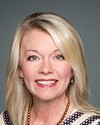Yes. Air traffic control provides positive control. The controller's main job is to keep aircraft separated so that they do not run into each other, in essence, and on the manoeuvring surface of the airport to make sure they're not going to run into a snowplow or some other vehicle out servicing the airport.
In order to do that, the pilots have to follow the air traffic controller's instructions. There's no discretion, unless there's an emergency. The controller tells the pilot to hold or denies a clearance to take off or a clearance to land. They'll only do that because they don't feel it's safe, because there is a potential obstruction.
In the flight advisory world, what happens is that the flight service specialist provides the pilot with all the information. He will tell a pilot what's going on, and then it's up to the pilot to decide the right thing to do.
Pilots are trained to operate in both and they're quite comfortable operating in both. The difference between the two is traffic volume. Obviously, in a given amount of air space, the more aircraft you add to it simultaneously, the more complex it becomes and the greater the possibility of something going wrong. That's why, everywhere in the world, we determine which level of service is correct based on the traffic volumes.
Interestingly, we use 60,000 movements a year as a guideline in Canada. In the U.S., it's 100,000 movements a year, and in other countries it's different numbers.
But that's essentially it. I guess it's the difference, if you want to use the analogy of driving, between coming to an intersection that has traffic lights and one that just has a stop sign. With the traffic lights, there is no discretion: if the light is red, you do not go through the intersection; you wait until it's green. That's like the controller telling you that it's okay, you can go now. With the stop sign, you look both ways and you determine when it's safe to go. That's the simplest analogy. But they all have the same information.
I believe Mr. Laframboise mentioned two incidents earlier. We've analyzed both of those incidents. They had nothing to do with the level of service at all. It wouldn't have made a difference if there had been three towers there at the time.




